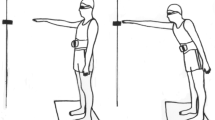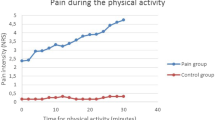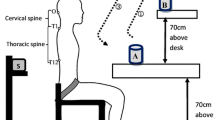Abstract
The aim of the present study was to investigate the effect of experimental and chronic neck–shoulder pain on the magnitude of cycle-to-cycle variability of task timing, kinematics and muscle activation during repetitive arm movement performed for 3 or 5 min. In an experimental part, acute muscle pain was induced in healthy subjects by intramuscular injection of hypertonic saline in trapezius (n = 10) and infraspinatus (n = 10) muscles. In a clinical part, workers with (n = 12) and without (n = 6) chronic neck–shoulder pain were compared. Cycle-to-cycle standard deviations of task duration, arm and trunk movement in 3D and surface electromyographic (EMG) root mean square activity were computed to assess the degree of variability. The variability in task timing increased in presence of both experimental and chronic pain (P < 0.05) compared with non-painful conditions. Experimental pain increased the variability of the starting position of the arm (P < 0.05), the arm range of motion (P < 0.01), the arm and trunk movement area (P < 0.01) and the acceleration of the arm (P < 0.01). In the chronic pain condition, the variability of arm and trunk acceleration (P < 0.01) and EMG activity (P < 0.05) was decreased compared with healthy controls. These results indicate that pain alters the magnitude of motor variability, and that the transition from acute to chronic pain is accompanied by changes in motor patterns. Experimental pain likely resulted in a quest for a motor solution reducing nociceptive influx, while chronic pain was characterised by a diminished motor flexibility.





Similar content being viewed by others
References
Arendt-Nielsen L, Graven-Nielsen T, Svarrer H, Svensson P (1996) The influence of low back pain on muscle activity and coordination during gait: a clinical and experimental study. Pain 64:231–240
Bernard BP (1997) Musculoskeletal disorders and worplace factors: a critical review of epidemiologic evidence for work-related musculoskeletal disorders of the neck, upper extremity and low back. US Department of Health and Human Services, Public Health Service, Center for Disease Control and Prevention, National Institute for Occupational Safety and Health
Birch L, Christensen H, Arendt-Nielsen L, Graven-Nielsen T, Sogaard K (2000) The influence of experimental muscle pain on motor unit activity during low-level contraction. Eur J Appl Physiol 83:200–206
Chau T, Young S, Redekop S (2005) Managing variability in the summary and comparison of gait data. J Neuroeng Rehabil 29:2–22
Christ M, Seyffart K, Wehling M (1999) Attenuation of heart-rate variability in postmenopausal women on progestin-containing hormone replacement therapy. Lancet 353:1939–1940
Enoka RM, Christou EA, Hunter SK, Kornatz KW, Semmler JG, Taylor AM, Tracy BL (2003) Mechanisms that contribute to differences in motor performance between young and old adults. J Electromyogr Kinesiol 13:1–12
Ervilha UF, Arendt-Nielsen L, Duarte M, Graven-Nielsen T (2004) The effect of muscle pain on elbow flexion and coactivation tasks. Exp Brain Res 156:174–182
Ervilha UF, Farina D, Arendt-Nielsen L, Graven-Nielsen T (2005) Experimental muscle pain changes motor control strategies in dynamic contractions. Exp Brain Res 164:215–224
Falla D, Graven-Nielsen T, Farina D (2006) Experimental muscle pain results in the reorganization of coordination among trapezius muscle subdivisions during repetitive shoulder flexion. Exp Brain Res. doi:10.1007/s00221-006-0746-6
Farina D, Leclerc F, Arendt-Nielsen L, Butteli O, Madeleine P (2006) The change in the spatial distribution of upper trapezius muscle activity is correlated to endurance time in static contraction. J Electromyogr Kinesiol. doi:10.1016/j.jelekin.2006.08.005
Frank TD, Friedrich R, Beek PJ (2006) Stochastic order parameter equation of isometric force production revealed by drift-diffusion estimates. Phys Rev. e 74.051905
Hodges PW, Moseley GL, Gabrielsson A, Gandevia SC (2003) Experimental muscle pain changes feedforward postural responses of the trunk muscles. Exp Brain Res 151:262–271
Johansson H, Sojka P (1991) Pathophysiological mechanisms involved in genesis and spread of muscular tension in occupational muscle pain and in chronic musculoskeletal pain syndromes: a hypothesis. Med Hypotheses 35:196–203
Kargo WJ, Nitz DA (2003) Early skill learning is expressed through selection and tuning of cortically represented muscle synergies. J Neurosci 23:11255–11269
Kilbom A, Persson J (1987) Work technique and its consequences for musculoskeletal disorders. Ergonomics 30:273–279
Lamoth CJC, Meijer OG, Daffertshofer A, Wuisman PIJM, Beek PJ (2006) Effects of chronic low back pain on trunk coordination and back muscle activity during walking: changes in motor control. Eur Spine J 15:23–40
Latash ML, Anson JG (2006) Synergies in health and disease: Relations to adaptive changes in motor coordination. Phys Ther 86:1151–1160
Latash ML, Scholz JP, Schoner G (2002) Motor control strategies revealed in the structure of motor variability. Exerc Sport Sci Rev 30:26–31
Le Pera D, Graven-Nielsen T, Valeriani M, Oliviero A, Di Lazzaro V, Tonali PA, Arendt-Nielsen L (2001) Inhibition of motor system excitability at cortical and spinal level by tonic muscle pain. Clin Neurophysiol 112:1633–1641
Lund JP, Donga R, Widmer CG, Stohler CS (1991) The pain-adaptation model: a discussion of the relationship between chronic musculoskeletal pain and motor activity. Can J Physiol Pharmacol 69:683–694
Madeleine P, Farina D (2007) Time to task failure in shoulder elevation is associated to increase in amplitude and to spatial heterogeneity of upper trapezius mechanomyographic signals. Eur J Appl Physiol. doi:10.1007/s00421-007-0589-2
Madeleine P, Lundager B, Voigt M, Arendt-Nielsen L (1998) Sensory manifestations in experimental and work-related chronic neck–shoulder pain. Eur J Pain 2:251–260
Madeleine P, Lundager B, Voigt M, Arendt-Nielsen L (1999) Shoulder muscle co-ordination during chronic and acute experimental neck–shoulder pain. An occupational study. Eur J Appl Physiol 79:127–140
Madeleine P, Lundager B, Voigt M, Arendt-Nielsen L (2003a) Standardized low-load repetitive work: evidence of different motor control strategies between experienced workers and a reference group. Appl Ergon 34:533–542
Madeleine P, Lundager B, Voigt M, Arendt-Nielsen L (2003b) The effects of neck–shoulder pain development on sensory–motor interaction among female workers in poultry and fish industries. A prospective study. Int Arch Occup Environ Health 76(1):39–49
Madeleine P, Leclerc F, Arendt-Nielsen L, Ravier P, Farina D (2006) Experimental muscle pain changes the spatial distribution of upper trapezius muscle activity during sustained contraction. Clin Neurophysiol 117:2436–2445
Madeleine P, Voigt M, Mathiassen SE (2007) Cycle-to-cycle variability in biomechanical exposure among butchers performing a standardized cutting task (submitted)
Mathiassen SE (2006) Diversity and variation in biomechanical exposure: what is it, and why would we like to know? Appl Ergon 37:419–427
Mathiassen SE, Moller T, Forsman M (2003) Variability in mechanical exposure within and between individuals performing a highly constrained industrial work task. Ergonomics 46:800–824
Moseley GL, Hodges PW (2006) Reduced variability of postural strategy prevents normalization of motor changes induced by back pain: a risk factor for chronic trouble? Behav Neurosci 120:474–476
Palmerud G, Kadefors R, Sporrong H, Järvholm U, Herberts P, Högfors C, Peterson B (1995) Voluntary redistribution of muscle activity in human shoulder muscle. Ergonomics 38:806–815
Punnett L, Wegman DH (2004) Work-related musculoskeletal disorders: the epidemiologic evidence and the debate. J Electromyogr Kinesiol 14:13–23
Schmidt RF, Kniffki K-D, Schomburg ED (1981) Der Einfluss kleinkalibriger Muskelafferenzen auf den Muskeltonus. In: Bauer H, Koella WP, Struppler H (eds) Therapie der Spastic. Verlag for angewandte Wissenschaft, München, pp 71–86
Sosnoff JJ, Newell KM (2006) Are age related increases in force variability due to decrements in strength? Exp Brain Res 174:86–94
Sosnoff JJ, Valantine AD, Newell KM (2006) Independence between the amount and structure of variability at low force levels. Neurosci Lett 392:165–169
Thunberg J, Ljubisavljevic M, Djupsjobacka M, Johansson H (2002) Effects on the fusimotor-muscle spindle system induced by intramuscular injections of hypertonic saline. Exp Brain Res 142:319–326
Travell JG, Rinzler S, Herman M (1942) Pain and disability of the shoulder and arm. JAMA 120:417–422
van Dieën JH, Vrielink HHEO, Housheer AF, Lotters FBJ, Toussaint HM (1993) Trunk extensor endurance and its relationship to electromyogram parameters. Eur J Appl Physiol 66:388–396
van Mourik AM, Daffertshofer A, Beek PJ (2006) Deterministic and stochastic features of rhythmic human movement. Biol Cybern 94:233–244
Veiersted KB, Westgaard RH, Andersen P (1990) Pattern of muscle activity during stereotyped work and its relation to muscle pain. Int Arch Occup Environ Health 62:31–41
Acknowledgments
The authors are grateful to Birthe Lundager (Social Medicine Unit, Aalborg Hospital) and Michael Voigt [Centre for Sensory-Motor Interaction (SMI), Aalborg University] for the help during data acquisition. This work was financially supported by Arbejdsmiljøforskningsfond, Sygekassernes Helsefond, Norma og Frode S. Jacobsens Fond, and the Danish National Research Foundation.
Author information
Authors and Affiliations
Corresponding author
Rights and permissions
About this article
Cite this article
Madeleine, P., Mathiassen, S.E. & Arendt-Nielsen, L. Changes in the degree of motor variability associated with experimental and chronic neck–shoulder pain during a standardised repetitive arm movement. Exp Brain Res 185, 689–698 (2008). https://doi.org/10.1007/s00221-007-1199-2
Received:
Accepted:
Published:
Issue Date:
DOI: https://doi.org/10.1007/s00221-007-1199-2




